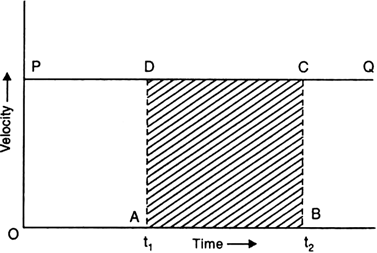Draw velocity-time graph for a body moving with uniform velocity. Hence show that the area under the velocity-time graph gives the distance travelled by the body in a given time interval.
Distance covered as area under the velocity-time graph. In Fig., line PQ is the velocity-time graph of a body moving with a uniform velocity, OP = v.
Area of rectangle ABCD
= AD × AB = OP × AB
= v × (t2 – t1)
= Velocity x time
= Distance travelled in time interval (t2 – t1)
Hence, the area under the velocity-time graph gives the distance travelled by the body in the given time interval.

Derive the equations of motion for uniformly accelerated motion from velocity-time graph.
Draw a velocity-time graph for a body in uniform acceleration. Hence, show that the area under the velocity-time graph gives the distance travelled by the body in the given time interval.
What types of motions are represented by the following velocity-time graphs?